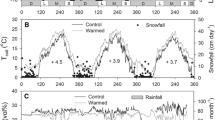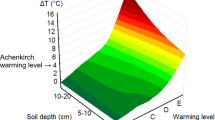Abstract
Climate projections predict higher temperatures and more frequent hurricanes in the tropics. Tropical plants subjected to these stresses may respond by acclimating their physiology. We investigated tropical forest root respiration in response to in situ experimental warming and hurricane disturbance in eastern Puerto Rico. We measured mass-normalized root specific respiration, root biomass, and root traits at the Tropical Responses to Altered Climate Experiment (TRACE), where understory vegetation is warmed + 4 °C above ambient. Our measurements span 5 years, including before and after two major hurricanes, to quantify root contributions to ecosystem carbon fluxes. Experimental warming did not affect root specific respiration at a standard temperature of 25° (RSR25, mean = 3.89 nmol CO2 g−1 s−1) or the temperature sensitivity of root respiration (Q10, mean = 1.75), but did result in decreased fine-root biomass, thereby decreasing area-based estimations of ecosystem-level root respiration in warmed plots by ~ 35%. RSR25 of newer roots, which increased with increasing root nitrogen, showed greater rates 6 months after the hurricanes, but subsequently decreased after 12 months. Root specific respiration did not acclimate to higher temperatures, based on lack of adjustments in either Q10 or RSR25 in the warmed plots; however, decreased root biomass indicates the root contribution to soil carbon dioxide efflux was overall lower with warming. Lower root biomass may also limit nutrient and water uptake, having potential negative effects on carbon assimilation. Our results show that warming and hurricane disturbance have strong potential to affect tropical forest roots, as well as ecosystem carbon fluxes.






Similar content being viewed by others
Data Availability
Data are available through ESS-DIVE at https://data.ess-dive.lbl.gov/view/doi:10.15485/2007467.
References
Atkin OK, Tjoelker MG. 2003. Thermal acclimation and the dynamic response of plant respiration to temperature. Trends Plant Sci 8:343–351.
Atkinson LJ, Hellicar MA, Fitter AH, Atkin OK. 2007. Impact of temperature on the relationship between respiration and nitrogen concentration in roots: an analysis of scaling relationships, Q10 values and thermal acclimation ratios. New Phytol 173:110–120.
Bond-Lamberty B, Wang C, Gower ST. 2004. A global relationship between the heterotrophic and autotrophic components of soil respiration? Glob Change Biol 10:1756–1766.
Bray RH, Kurtz LT. 1945. Determination of total, organic, and available forms of phosphorus in soils. Soil Sci 59:39–46.
Bryla DR, Bouma TJ, Eissenstat DM. 1997. Root respiration in citrus acclimates to temperature and slows during drought. Plant Cell Environ 20:1411–1420.
Carter KR, Wood TE, Reed SC, Schwartz EC, Reinsel MB, Yang X, Cavaleri MA. 2020. Understory shrubs show limited photosynthetic acclimation and no respiratory acclimation in response to in situ experimental warming of a wet tropical forest. Front for Glob Change 3:1–71.
Cavaleri MA, Reed SC, Smith WK, Wood TE. 2015. Urgent need for warming experiments in tropical forests. Glob Change Biol 21:2111–2121.
Doughty CE, Goulden ML. 2008. Are tropical forests near a high temperature threshold? J Geophys Res Biogeosciences 114:1–12.
Gutiérrez del Arroyo O, Wood TE. 2020. Significant diel variation of soil respiration suggests aboveground and belowground controls in a tropical moist forest in Puerto Rico. J Geophys Res Biogeosciences 125. https://onlinelibrary.wiley.com/doi/abs/https://doi.org/10.1029/2019JG005353. Last accessed 14/12/2022
Gutiérrez del Arroyo O, Wood TE. 2021. Large seasonal variation of soil respiration in a secondary tropical moist forest in Puerto Rico. Ecol Evol 11:263–272.
Hopkins F, Gonzalez-Meler MA, Flower CE, Lynch DJ, Czimczik C, Tang J, Subke J. 2013. Ecosystem-level controls on root-rhizosphere respiration. New Phytol 199:339–351.
IPCC. 2018. Global warming of 1.5 °C An IPCC Special Report on the impacts of global warming of 1.5°C above pre-industrial levels and related global greenhouse gas emission pathways, in the context of strengthening the global response to the threat of climate change.
Jarvi MP, Burton AJ. 2013. Acclimation and soil moisture constrain sugar maple root respiration in experimentally warmed soil. Tree Physiol 33:949–959.
Jobbagy EG, Jackson RB. 2000. The vertical distribution of soil organic carbon and its relation to climate and vegetation. Ecol Appl 10:423.
Johnstone JF, Allen CD, Franklin JF, Frelich LE, Harvey BJ, Higuera PE, Mack MC, Meentemeyer RK, Metz MR, Perry GLW, Schoennagel T, Turner MG. 2016. Changing disturbance regimes, ecological memory, and forest resilience. Front Ecol Environ 14:369–378.
Kaneda S, Zedníková P, Frouz J. 2022. Herbaceous and woody root biomass, seasonal changes in root turnover, and arbuscular mycorrhizal and ectomycorrhizal colonization during primary succession in post-mining sites. Diversity 14:644.
Kennard DK, Matlaga D, Sharpe J, King C, Alonso-Rodríguez AM, Reed SC, Cavaleri MA, Wood TE. 2020. Tropical understory herbaceous community responds more strongly to hurricane disturbance than to experimental warming. Ecol Evol 10:8906–8915.
Kimball BA, Alonso-Rodríguez AM, Cavaleri MA, Reed SC, González G, Wood TE. 2018. Infrared heater system for warming tropical forest understory plants and soils. Ecol Evol 8:1932–1944.
Knutson T, Camargo SJ, Chan JCL, Emanuel K, Ho CH, Kossin J, Mohapatra M, Satoh M, Sugi M, Walsh K, Wu L. 2019. Tropical cyclones and climate change assessment. Bull Am Meteorol Soc 100:1987–2007.
Loveys BR, Atkinson LJ, Sherlock DJ, Roberts RL, Fitter AH, Atkin OK. 2003. Thermal acclimation of leaf and root respiration: an investigation comparing inherently fast- and slow-growing plant species. Glob Change Biol 9:895–910.
Mau AC, Reed SC, Wood TE, Cavaleri MA. 2018. Temperate and tropical forest canopies are already functioning beyond their thermal thresholds for photosynthesis. Forests 9:1–24.
Melillo JM, Butler S, Johnson J, Mohan J, Steudler P, Lux H, Burrows E, Bowles F, Smith R, Scott L, Vario C, Hill T, Burton A, Zhouj YM, Tang J. 2011. Soil warming, carbon-nitrogen interactions, and forest carbon budgets. Proc Natl Acad Sci U S A 108:9508–9512.
Murphy SF, Stallard RF, Scholl MA, González G, Torres-Sánchez AJ. 2017. Reassessing rainfall in the Luquillo Mountains, Puerto Rico: local and global ecohydrological implications. PLoS ONE 12.
Noh NJ, Crous KY, Li J, Choury Z, Barton CVM, Arndt SK, Reich PB, Tjoelker MG, Pendall E. 2020. Does root respiration in Australian rainforest tree seedlings acclimate to experimental warming? Tree Physiol 40:1192–1204.
Nottingham AT, Meir P, Velasquez E, Turner BL. 2020. Soil carbon loss by experimental warming in a tropical forest. Nature 584:234–237.
Paradiso E, Jevon F, Matthes J. 2019. Fine root respiration is more strongly correlated with root traits than tree species identity. Ecosphere 10.
R Core Team. 2022. R: A Language and Environment for Statistical Computing. https://www.r-project.org/
Reed SC, Cleveland CC, Townsend AR. 2008. Tree species control rates of free-living nitrogen fixation in a tropical rain forest. Ecology 89:2924–2934.
Reed SC, Reibold R, Cavaleri MA, Alonso-Rodríguez AM, Berberich ME, Wood TE. 2020. Soil biogeochemical responses of a tropical forest to warming and hurricane disturbance. Elsevier Ltd. https://doi.org/10.1016/bs.aecr.2020.01.007.
Robertson GP, Wedin DA, Groffmann PM, Blair JM, Holland E, Nadelhoffer KJ, Harris DJ. 1999. Soil carbon and nitrogen availability: Nitrogen mineralization, nitrification, and soil respiration potentials. Standard methods of long-term ecological research, . Oxford University Press: New York, New York, USA. pp 258–271.
Roumet C, Birouste M, Picon-Cochard C, Ghestem M, Osman N, Vrignon-Brenas S, Cao K, Stokes A. 2016. Root structure–function relationships in 74 species: evidence of a root economics spectrum related to carbon economy. New Phytol 210:815–826.
Scatena FN. 1989. An introduction to the physiography and history of the Bisley Experimental Watersheds in the Luquillo Mountains of Puerto Rico.
Silver WL, Vogt KA. 1993. Fine root dynamics following single and multiple disturbances in a subtropical wet forest ecosystem. J Ecol 81:729.
Slot M, Kitajima K. 2015. General patterns of acclimation of leaf respiration to elevated temperatures across biomes and plant types. Oecologia 177:885–900.
Subke J-A, Bahn M. 2010. On the ‘temperature sensitivity’ of soil respiration: can we use the immeasurable to predict the unknown? Soil Biol Biochem 42:1653–1656.
Tarnocai C, Canadell JG, Schuur EAG, Kuhry P, Mazhitova G, Zimov S. 2009. Soil organic carbon pools in the northern circumpolar permafrost region: SOIL ORGANIC CARBON POOLS. Glob Biogeochem Cycles 23:n/a-n/a.
Tjoelker MG. 2018. The role of thermal acclimation of plant respiration under climate warming: putting the brakes on a runaway train? Plant Cell Environ 41:501–503.
Wang J, Defrenne C, McCormack ML, Yang L, Tian D, Luo Y, Hou E, Yan T, Li Z, Bu W, Chen Y, Niu S. 2021. Fine-root functional trait responses to experimental warming: a global meta-analysis. New Phytol 230:1856–1867.
Warren JM, Hanson PJ, Iversen CM, Kumar J, Walker AP, Wullschleger SD. 2015. Root structural and functional dynamics in terrestrial biosphere models-evaluation and recommendations. New Phytol 205:59–78.
Wright IJ, Reich PB, Westoby M, Ackerly DD, Baruch Z, Bongers F, Cavender-Bares J, Chapin T, Cornelissen JHC, Diemer M, Flexas J, Garnier E, Groom PK, Gulias J, Hikosaka K, Lamont BB, Lee T, Lee W, Lusk C, Midgley JJ, Navas M-L, Niinemets Ü, Oleksyn J, Osada N, Poorter H, Poot P, Prior L, Pyankov VI, Roumet C, Thomas SC, Tjoelker MG, Veneklaas EJ, Villar R. 2004. The worldwide leaf economics spectrum. Nature 428:821–827.
Yaffar D, Wood TE, Reed SC, Branoff BL, Cavaleri MA, Norby RJ. 2021. Experimental warming and its legacy effects on root dynamics following two hurricane disturbances in a wet tropical forest. Glob Change Biol. https://onlinelibrary.wiley.com/doi/https://doi.org/10.1111/gcb.15870
Acknowledgements
This research was funded by the U.S. Department of Energy under the award numbers DE-SC-0012000, DE-SC-0011806, 89243018S-SC-000014, DE-SC-0018942, and DE-SC-0022095 and a National Science Foundation award DEB-1754713. Additional support was provided by the U.S Forest Service International Institute of Tropical Forestry, U.S. Geological Survey’s Ecosystem Mission Area, and Michigan Technological University’s Ecosystem Science Center. We would like to thank the past and present TRACE project managers: Aura Alonso-Rodríguez, Megan Berberich, Isabel Loza Rivera, and Iana Grullón-Penkova, TRACE technicians: William Mejía-García, Nicole Gutiérrez Ramos, Armin Howell, and Robin Reibold, and the many TRACE interns and volunteers who helped collect data for this manuscript. We would also like to thank Mickey Jarvi and Kelsey Carter from Michigan Tech who helped with respiration setup and root sample processing, respectively. Any use of trade, firm, or product names is for descriptive purposes only and does not imply endorsement by the U.S. Government.
Author information
Authors and Affiliations
Corresponding author
Ethics declarations
Conflict of interest
The authors do not have any conflicts of interest.
Additional information
Author Contributions: TEW, SCR, and MAC designed the study experiment. TEW, SCR, MAC, and RT collected and interpreted the data. RT performed data analysis. TEW, SCR, MAC, and RT contributed to writing the manuscript.
Rights and permissions
Springer Nature or its licensor (e.g. a society or other partner) holds exclusive rights to this article under a publishing agreement with the author(s) or other rightsholder(s); author self-archiving of the accepted manuscript version of this article is solely governed by the terms of such publishing agreement and applicable law.
About this article
Cite this article
Tunison, R., Wood, T.E., Reed, S.C. et al. Respiratory Acclimation of Tropical Forest Roots in Response to In Situ Experimental Warming and Hurricane Disturbance. Ecosystems 27, 168–184 (2024). https://doi.org/10.1007/s10021-023-00880-y
Received:
Accepted:
Published:
Issue Date:
DOI: https://doi.org/10.1007/s10021-023-00880-y




